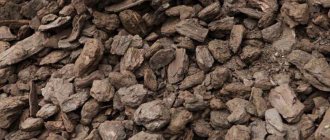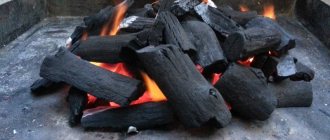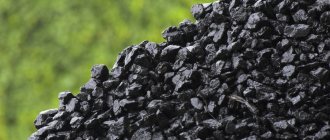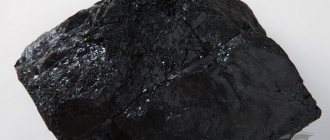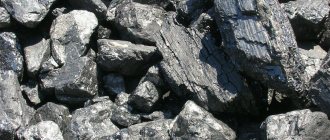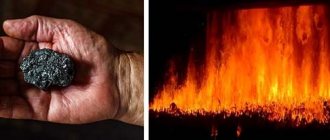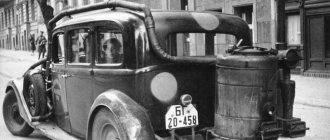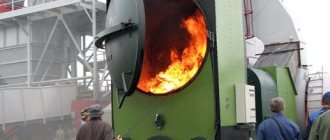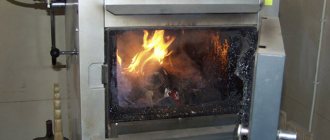Coal is an organic substance that is formed from plant residues. Under the influence of pressure and temperature, peat deposits turned into rock over centuries. First - in brown coal, then - in coal, which transformed into anthracite.
At each stage, coal changes its characteristic properties, which directly affect its quality. What are the fundamental differences between each type?
Brown coal
Brown coal is the youngest solid rock, formed about 50 million years ago from peat or lignite. At its core, it is “immature” coal.
This mineral got its name because of its color - shades vary from brownish-red to black. Brown coal is considered a fuel of low degree of carbonization (metamorphism). It contains 50% carbon, but also a lot of volatile substances, mineral impurities and moisture, so it burns much easier and produces more smoke and a burning smell.
Depending on the humidity, brown coal is divided into grades 1B (humidity more than 40%), 2B (30-40%) and 3B (up to 30%). The yield of volatile substances in brown coals is up to 50%.
With prolonged contact with air, brown coal tends to lose its structure and crack. Among all types of coal, it is considered the lowest quality fuel, since it emits much less heat: the calorific value is only 4000 - 5500 kcal/kg .
Brown coal lies at shallow depths (up to 1 km), so it is much easier and cheaper to mine. However, in Russia it is used much less frequently as a fuel than coal. Due to its low cost, brown coal is still preferred by some small and private boiler houses and thermal power plants.
In Russia, the largest deposits of brown coal are located in the Kansk-Achinsk basin (Krasnoyarsk Territory). In total, the area has reserves of almost 640 billion tons (about 140 billion tons are suitable for open-pit mining).
The only coal deposit in Altai is Soltonskoye . Its predicted reserves are 250 million tons .
About 2 trillion tons of brown coal are hidden in the Lena coal basin, located on the territory of Yakutia and the Krasnoyarsk Territory. In addition, this type of mineral often occurs together with coal - for example, it is also obtained from the deposits of the Minusinsk and Kuznetsk coal basins.
reference Information
General information
Fossil coal is a solid combustible organic rock formed primarily from dead plants as a result of their biochemical, physicochemical and physical changes.
Main components: organic matter that carries the combustible and other technological properties of coal, mineral inclusions and moisture. Changes in the organic matter (OM) of coal in the depths lead to the creation of compounds that ensure the vital activity of plant organisms and transform the OM into substances that are persistent in the fossil state.
The diversity of the composition and properties of coal is due to the composition of the source material and the unequal influence of a complex of geological and genetic factors on the characteristics of the accumulation and subsequent transformation of the original biomass.
Depending on the composition of the starting material, coals are divided into humus, humus-sapropel and sapropel.
Humic coals (humolites) were formed mainly from the transformation product of dead higher plants: cellulose, lignite, hemicellulose, proteins, fats, resins. The products of the transformation of dead lower plants and protozoan animals under anaerobic conditions were the basis for the formation of sapropel coals (sapropelites). If the content of the cellulose-lignin complex in higher plants reaches more than 80%, then in lower plants, such as algae, lignin is practically absent, and the content cellulose does not exceed 20%. The predominant substances in them are proteins, fats, waxes, resins. The most common are humus coals.
Depending on the nature and degree of transformation of OB coals, in accordance with the tradition adopted in the Russian Federation, are divided into three groups: brown, hard and anthracite.
Brown coal is coal of a low stage of metamorphism with reflectance indices of vitrinite (huminite) less than 0.6%, provided that the higher calorific value of the wet, ash-free state of coal is less than 24 MJ/kg. There are soft and dense varieties of brown coals.
Soft brown coal is earthy, leafy, less often massive and dense, matte and semi-matte, fawn, brown, brown in color. Its humidity varies between 40-60%. carbon content in organic matter is 63-73%.
Dense brown coal is uniform or banded, streaky, semi-matte and matte, semi-shiny and shiny brown or black with a brown tint. In a piece, coal often has a characteristic conchoidal, splintered, sometimes even fracture. Compared to hard coal, brown coal has a less dense composition, contains less carbon in organic matter, but more oxygen, and is characterized by a high yield of volatile substances. Moisture content ranges from 19 to 44.5%.
In air, brown coal quickly loses free moisture and cracks. Its OM is dominated by humic substances with acidic properties and high hydrophilicity. When treated with alkalis, the yield of humic acids reaches 88% in soft varieties and decreases to 2% in the densest varieties. During dry distillation without air access, a lot of volatile substances are released (33-60%). The yield of primary tar varies from a few to 25% or more. Lower calorific value Q i r
ranges from 7 to 17 MJ/kg, the highest (
Q s daf
) - dry ash-free fuel reaches 29 MJ/kg. The color of the line on an unglazed porcelain plate ranges from brown to black (dense varieties).
Coal
is formed at the middle stage of metamorphism with a vitrinite reflectance from 0.4 to 2.59%, provided that the higher calorific value (for the wet ashless state of coal) is equal to or higher than 24 MJ/kg, and the yield of volatile substances (for the dry ashless state of coal ) is equal to 8% or more.
Compared to brown coal, it is characterized by a higher degree of carbonization (carbon content reaches 92%), as a rule, by the absence of humic acids. The yield of volatile substances ranges from 8-50%. When heated without air access, the organic matter of coal is sintered to a greater or lesser extent. The sintering property is the most important
when assessing the suitability of coal for coke production.
Anthracite belongs to coals of a high stage of metamorphism with a vitrinite reflection index of more than 2.59%, provided that the yield of volatile substances (on a dry, ash-free state of coal) is not less than 9%. When the release of volatile substances is less than 8%, coal with a vitrinite reflection index of 2.20 to 2.59% (classes 22-25) is also classified as anthracite. Anthracite is a dense coal of grayish-black or black-gray color with a metallic sheen and conchoidal fracture. It is characterized by high density (1.42-1.8 g/cm), low electrical resistivity (10-3-10 Ohm-m), high microhardness (300-1470 cu). Anthracite has a low yield of volatile substances: from 1.5 to 9.0%, as a result of which its flame is relatively smokeless. It contains little moisture, and its elemental composition has a low content of oxygen and hydrogen.
The total geological reserves of coal contained in coal-bearing formations of all geological systems are about 14,000 billion tons. They are concentrated in the following countries (in billion tons): Russian Federation - 4731.9 (former USSR - 6800), USA - 3600, China - 1500, Australia - 697, Canada - 547, Germany - 287, South Africa - 206, Great Britain - 189, Poland - 174, India - 125.
Areas of use
It is used mainly in the energy sector and for the production of coke, and to a lesser extent - for gasification and semi-coking, for the production of refined fuel (gas and liquid products) for domestic needs, in transport, in brick production, lime burning and other areas.
In relatively small volumes, coal is used for special technological purposes: the production of thermoanthracite and thermographite, carbon-graphite products, carbon adsorbents, silicon and calcium carbides, carbon-alkaline reagents, and rock wax.
The direction of use of various technological brands, groups and subgroups is given in table. 1.
Coal accounts for about 35% of global energy consumption. In 2007, about 28% of mined coal in Russia was used for energy purposes, 22.8% for coke production, 25.6% in other industries, and 23.8% for domestic needs.
Brown coal is not only an energy fuel, but also a valuable raw material for technological processing. Lignite coke is used to replace metallurgical coke in the production of ferroalloys, phosphorus, and calcium carbide. Granular adsorbents and semi-coke obtained from brown coal are of great importance. Processes for the hydrogenation of brown coals, new methods for their gasification and the production of chemical products have been developed. Brown coals of technological group 1B are raw materials for the production of rock wax used in the paper, textile, leather, woodworking industries, and road construction.
Table 1.
Directions for using upey of various technological brands, groups and subgroups
| Direction of use | Brands, groups and subgroups |
| 1. Technological | |
| 1.1. Layer coking | All groups and subgroups of brands: DG, G, GZhO, GZh, Zh, KZh, K, KO, KSN, KS, OS, TS, SS |
| 1.2. Special preparation processes for coking | All coals used for layer coking, as well as grades T and D (DV subgroup) |
| 1.3. Production of generator gas in stationary gas generators: | |
| mixed gas | Brands KS, SS, groups: ZB, 1GZhO, subgroups - DGF, TSV, 1TV |
| water gas | Group 2T, as well as anthracites |
| 1.4. Production of synthetic liquid fuels | Brand GZh, groups: 1B, 2G, subgroups - 2BV, ZBV, DV, DGV, 1GV |
| 1.5. Semi-coking | Brand DG, groups: 1B, 1G, subgroups - 2BV, ZBV, DV |
| 1.6. Production of carbon filler (thermoanthracite) for electrode products and foundry coke | Groups 2L, ZA, subgroups - 2TF and 1AF |
| 1.7. Production of calcium carbide, electrocorundum | All anthracites, as well as subgroup 2TF |
| 2. Energy | |
| 2.1. Pulverized and layer combustion in stationary boiler plants | Weight of brown coals and atracites, as well as bituminous coals not used for coking. Anthracites are not used for flare-bed combustion |
| 2.2. Combustion in reverberatory furnaces | Brand DG, i group - 1G, 1SS, 2SS |
| 2.3. Combustion in mobile heating units and use for municipal and domestic needs | Grades D, DG, G, SS, T, A, brown coals, anthracites and hard coals not used for coking |
| 3. Production of building materials | |
| 3.1. Lime | Brands D, DG, SS, A, groups 2B and ZB; grades GZh, K and groups 2G, 2Zh not used for coking |
| 3.2. Cement | Brands B, DG, SS, TS, T, L, subgroup DV and grades KS, KSN, groups 27, 1GZhO not used for coking |
| 3.3. Brick | Coals not used for coking |
| 4. Other production | |
| 4.1. Carbon adsorbents | Subgroups: DV, 1GV, 1GZHOV, 2GZHOV |
| 4.2. Active carbons | Group ZSS, subgroup 2TF |
| 4.3. Ore agglomeration | Subgroups: 2TF, 1AV, 1AF, 2AV, ZAV |
Brown coal semi-cokes are used as fillers for plastics, various composite materials, as sorbents, ion exchangers, and catalysts. Thermal coal is obtained from coals of technological groups 2B and 3B.
More than 80% of coal coke is used for smelting pig iron. Other coking products, gas, tar are used in the chemical industry (35%), non-ferrous metallurgy (30%), agriculture (23%), construction industry, railway transport, road construction (12%). About 190 types of chemical substances are obtained from coking products. About 90% of manufactured fibers, 60% of plastics, 30% of synthetic rubber are produced on the basis of compounds obtained from the processing of coal. The coke industry is the main supplier of benzene, toluene, xylene, high-boiling aromatic, cyclic, nitrogen- and sulfur-containing compounds, phenols, unsaturated compounds, naphthalene, and anthracene.
Coal tar pitch is used to produce pitch coke, which is used as a component of electrodes in the aluminum industry, as well as in the production of carbon fibers and carbon black.
High electrical conductivity, comparative resistance to oxidation processes, increased resistance to aggressive environments and abrasion determine a wide range of anthracite use in various industries. It is a high-grade fuel, as well as the starting raw material for the production of thermoanthracite, thermographite, carbonizers, carburizers, calcium and silicon carbides, electrodes for the metallurgical industry, carbon adsorbents, colloidal graphite preparations.
Coal composition
The main components of coal are organic components and mineral inclusions. Organic components, distinguishable under a microscope, with characteristic morphological features, color and reflectance are called microcomponents (macerals).
Unlike minerals, they do not have a characteristic crystalline form and a constant chemical composition. The chemical and physical properties of microcomponents change during the carbonization process.
There are four groups of microcomponents: vitrinite, semivitrinite, inertinite and liptinite.
Microcomponents of the vitrinite group
are characterized by a predominantly flat surface, gray color of various shades in reflected light, a weakly expressed microrelief and the ability, with a certain degree of carbonization, to transform into a plastic state. The reflectance index ranges from 0.4 to 4.5%. Microhardness, depending on carbonization and genetic factors, ranges from 200 to 350 MPa.
Microcomponents of the semivitrinite group
in terms of physical and chemical properties, they occupy an intermediate position between the microcomponents of the vitripite and inertinite groups. They are characterized by a whitish-gray color of various shades in reflected light and the absence of microrelief. Their reflectance always exceeds the reflectance of vitrinite. Microhardness ranges from 250 to 420 MPa. During coking processes, microcomponents of this group do not transform into a plastic state, but are capable of softening.
Microcomponents of the inertinite group
characterized by a high reflectance and a pronounced microrelief. The color varies from white to yellow. Microhardness ranges from 500 to 2300 MPa. Microcomponents of this group do not transform into a plastic state and do not sinter.
Microcomponents of the liptinite group
differ from each other according to morphological characteristics. The color of liptinite varies from dark brown, black to dark gray and grey. The reflection rate of this group is the lowest: from 0.21 to 1.59%. Microhardness ranges from 80 to 250 MPa. During coking, microcomponents of this group form a more mobile plastic mass compared to vitrinite.
Mineral inclusions in coals are clay minerals, iron sulfides, carbonates, silicon oxides and others.
Clay minerals on average account for approximately 60-80% of the total minerals associated with coal. Most often they are represented by illite, sericite, montmorillonite, and kaolinite. Halloysite is less common.
Clay minerals are composed of particles up to 100 microns in size. They occur in the form of lenses, interlayers or finely dispersed particles in vitrinite. Often, cavities are made in components with a botanical structure or their individual sections are replaced. Coal seams sometimes contain layers of tonsteins, in which the main rock-forming mineral is kaolinite.
The most common iron sulfides are pyrite, marcasite and melnikovite. The form of their presence in the layers is different and is determined by the conditions of formation. Syngenetic formations occur in the form of individual grains, pseudomorphs from plant remains, nodules, and interlayers. Epigenetic sulfides typically perform cracks.
Carbonates are represented by calcite, siderite, dolomite, and ankerite. Calcite often forms thin layers or fills cracks in coal. Siderite occurs in the form of round or oval formations (oolites) or fills the cavities of plant fragments.
Silicon oxides are represented in coals by quartz, chalcedony, opal and other minerals.
Quartz occurs in the form of small interlayers, rounded and cylindrical grains, and sometimes forms rather large lenses. Chalcedony is found relatively less frequently, usually together with quartz. In the weathering zones of coal in some basins, gypsum is observed filling cracks, less often in the form of nodules.
Other mineral inclusions are mainly iron hydroxides, phosphates, feldspars, and salts.
Use of coal in energy.
Coals of all brands and types can be used for combustion. The main indicators of the quality of steam coal are working and hygroscopic moisture, ash content, volatile matter yield, sulfur content, sieve composition, lower calorific value of working fuel, composition and fusibility of ash. For layered combustion, the indicators of mechanical strength and thermal resistance of coal are also regulated, and for pulverized coal - grindability.
Industry requirements for thermal coals are regulated by state standards that limit the maximum moisture content, ash content, lump size, and rock content.
Layer combustion
imposes the most stringent requirements on fuel. The most important characteristics are sieve composition, caking ability, ash content, volatile matter yield, reactivity and thermal ability of the fuel. Containing both fines and large pieces in coals is undesirable. For standard layer fireboxes, the most suitable pieces of fuel are the following sizes: 6-12 mm (brown coals), 12-25 and 25-50 mm (hard coals).
Flare bed combustion
imposes less stringent requirements on the fuel sieve composition. For fireboxes of this type, screenings, raw coals and coals with sizes of 0-25, 0-50 mm are supplied.
Pulverized coal combustion method
- the main one in large-scale energy and allows you to burn fuel with an ash content of up to 45% and a humidity of up to 55%. Fuel during pulverized coal combustion is pre-ground and dried (for high-moisture coals). Increased requirements for the stability of coal composition, the composition and properties of ash, and the grindability of fuel.
Strict requirements for studying the composition and properties of ash are imposed on coals with low-melting ash burned in furnaces with liquid slag removal. For pulverized combustion, raw coals, middlings and screenings of all grades are supplied, which are not suitable for coking and other special purposes. The sulfur content of coals is limited. The possibilities for using high-sulfur coals are mainly limited by the content of harmful gases and ash content, fuel consumption, the height of chimneys, and the possibility of identifying sanitary protection zones.
Coals for cement kilns.
Requirements for coals intended for cement kilns normalize the content of ash, moisture, the yield of volatile substances, the thickness of the plastic layer, the heat of combustion, lumpiness, the content of fines and mineral impurities.
Coals for lime kilns.
The requirements for these coals include restrictions on ash content, moisture, lumpiness, fines content, and grade composition.
Coals for firing bricks.
In coals for brick production, ash content, moisture, thickness of the plastic layer, heat of combustion, volatile yield, lumpiness, content of fines and mineral impurities are standardized.
Coals for municipal needs.
The requirements for these coals determine the grade composition and groups of coals, the yield of volatile substances, the thickness of the plastic layer, the heat of combustion, humidity, lumpiness, the content of fines and mineral impurities.
Coal quality testing
All indicators of the composition and properties of coal and their quality characteristics have symbols in the form of alphabetic symbols and indices.
Analyzed states of coal: working (d), analytical (a), dry (d).
Conditional states of coal: dry ash-free (daf), wet ash-free (af), organic matter (o).
All properties and parameters characterizing the quality of coal are determined in accordance with regulatory and methodological documents, a list of which is given in the appendix.
In each working seam, coal lithotypes are macroscopically identified and the average microcomponent composition of the identified lithotypes and the seam as a whole is determined.
Grading
— quantitative characteristics of coal by size of pieces — standardized for all types of use. Coal is divided into size classes by sorting it (screening) on sieves with holes of appropriate sizes.
Mechanical strength
coal is studied according to two parameters: the ability of coal to maintain the size of pieces upon impact and upon abrasion. It is necessary when using coals for gasification, producing thermoanthracites, in electrode and foundry industries.
Thermal strength
coal is characterized by mechanical strength in pieces after heat treatment. It is studied in coals intended for combustion in vehicle furnaces, semi-coking, hydrogenation and the production of foundry electrode anthracites.
Electrical properties
serve to assess the stages of metamorphism: coals at low stages are dielectrics, at medium stages they are semiconductors, at high stages (anthracites) they are conductors.
Density of coals
characterizes its porosity.
In its natural state, coal extracted from the depths usually has numerous cracks and includes pores (cavities) of various shapes and sizes. A distinction is made between actual (dr)
and apparent
(da),
closed and open porosity.
Elemental analysis
includes the determination of the content of the following basic elements in organic matter: carbon, hydrogen, nitrogen, oxygen and organic sulfur.
Since carbon, hydrogen and oxygen are contained in the mineral part of coals, are included in the composition of carbonates, oxides, and are also contained in the hydration water of silicates, the content of these elements is distinguished accordingly: total (ct, Ht, ot),
in organic mass
(co, Ho, oo)
and in the mineral part of coals
(cm, Hm, om)
.
Technical analysis
combines the determination of the main indicators of coal quality, provided for by the requirements of regulatory documents for all types of their use. Coal quality indicators include: humidity, ash content, sulfur content, phosphorus content, volatile matter yield, calorific value. In cases where the direction of use of coal from a particular deposit is sufficiently determined, a shortened technical analysis is carried out, including determination of only the ash content of coal, moisture content and the yield of volatile substances.
Ash content
It is the ratio (in %) of the mass of inorganic residue (ash) obtained after complete combustion of coal to the mass of the coal sample under study.
The main components are the oxides of Si, Al, Fe, Ca, Mg, Na, K
, and the oxides
Ti, P, and Mn
.
The yield and composition of ash depend on the nature of the coal, the conditions of its combustion (primarily on the rate of ashing and the final calcination temperature). Based on the composition of the ash, coals are divided into siliceous ( SiO2
40-70%), aluminous (
A2O3
30-45%), ferruginous (
Fe2O3
> 20%), calcareous (
CaO -
20-40%).
Humidity is divided into surface (wetting moisture), maximum ( Wmax
moisture capacity of coal, characteristic of its chemical nature, petrographic composition, degree of carbonization), air-dry coal (represented by adsorption bound water and characterizes the porosity and hydrophilic properties of the surface of coal particles) and total (total amount of external moisture and moisture of air-dry coal).
Coal sulfur content.
The mass fraction of total sulfur
(Std)
in coals varies widely.
Based on this value, coals are divided into low-sulfur (up to 1.5%), medium-sulfur (1.5-2.5%). sulfur (2.5-4%) and high-sulfur (more than 4%). Sulfur is part of organic matter, the mineral part of coal, and is sometimes present in elemental form. The following types of sulfur are distinguished: organic (So),
sulfide
(Ss),
sulfate
(SSO4).
Phosphorus content (P)
in coals usually does not exceed 0.05%. Its mass fraction is limited only in coals sent for the production of special grades of blast furnace coke (<0.012%), as well as in anthracites used in the production of calcium carbide (<0.05%).
Volatile yield (V)
assessed when putting coal on without air access by the rate of decomposition into gas and vapor products and solid non-volatile folds.
The composition of volatile products is primary tar (for brown coals) or coal tar (for hard coals). They consist of gases (CO, CO2, H2, CH2)
and volatile hydrocarbons and their derivatives, as well as water.
The heat of combustion of coal
(Q)
is used to compare the thermal properties of coal from different deposits and grades with each other and with other types of fuel.
The calorific value is determined by measuring the amount of heat released per unit mass of coal during its complete combustion in a calorimetric bomb in a compressed oxygen environment under standard conditions. By corresponding recalculations of the heat of combustion values, the values of the highest heat of combustion (Qs)
with the exclusion of the heat obtained due to acid formation, and the lower
(Qi)
heat of combustion with the additional exclusion of the heat obtained due to the evaporation of water are obtained.
The thermal properties of coals are characterized by caking and coking properties.
Caking ability
- the property of coal, when heated without air access, to transform into a plastic state with the formation of a bound non-volatile residue. The property of coals to sinter an inert material with the formation of such a residue is called sintering ability. When coals of a certain petrographic composition and degree of carbonization are heated above 300°C without air access, gas and liquid products are released from them. At a temperature of 500-550°C, the mass hardens and a sintered solid residue is formed - semi-coke. With a further increase in temperature (up to 1000 C or more), the content of oxygen, hydrogen, and sulfur in the charcoal decreases, and the carbon content increases. Semi-coke turns into coke. Coals of stages II-V of metamorphism and a certain petrographic composition have sinterability.
Coking ability
— the property of crushed coal to sinter with the subsequent formation of coke with a specified size and strength of the pieces. It is studied by direct (laboratory, box and semi-plant coking) and indirect methods.
Group analysis
Most often it is used to assess the quality of brown coals, in which, when treated with solvents or chemical reagents, part of the organic mass of coal goes into solutions and some substances obtained from extracts (bitumen, humic acids) are used in various sectors of the national economy. Bitumen extracted from light brown coals with organic solvents (benzene, gasoline, etc.) are mainly represented by waxes and resins. The minimum content of waxy bitumen in brown coals used in industry is 7%. Humic acids of coal are a mixture of acidic high-molecular amorphous dark-colored organic substances with a high degree of oxidation and hydrophilicity, extracted from coal with aqueous alkaline solutions. The yield of humic acids from brown and oxidized coals ranges from zero to 100% of organic mass.
Microelements
in coals they are found in both organic and mineral mass. They are represented by compounds of non-ferrous metals, rare and trace elements, the total concentration of which usually does not exceed 1% of the dry mass of coal. Uranium and germanium are of greatest practical importance for extraction. In addition, gallium, vanadium and others can be extracted along the way. To determine the content of “minor” elements in coals, spectral, spectrophotometric, activation and atomic absorption methods are used.
Applications
Classification of coals by size of pieces
(GOST 19242-73)
| Classes | Legend | Piece size limits | |
| lower | upper | ||
| Varietal | |||
| Slab | P | 100(80) | 200; 300 |
| Large (fist) | TO | 50 (40) | 100(80) |
| Nut | ABOUT | 25 (20) | 50 (40) |
| Small | M | 13(10) | 25 (20) |
| seed | WITH | 6 (5;  | 13(10) |
| Shtyb | Sh | 0 | 6 (5;  |
| Combined and dropouts | |||
| Large with slab | PC | 50 (40) | 200; 300 |
| Walnut with large | KO | 25 (20) | 100(80) |
| Small with nut | OM | 13(10) | 50 (40) |
| Seed with small | MS | 6 (5;  | 25 (20) |
| Seed with a stump | SSH | 0 | 13(10) |
| Small with seed and piece | MSH | 0 | 50 (40) |
| Nut with small, seed and piece | OMSSH | 0 | 25(20) |
| Private | R | 0 | 200; 300 |
Thermobaric conditions of the Earth's interior that led to the formation of coal of certain grades
| Coal grade | Index | Metamorphism stage | Main settings | ||
| Immersion depth , (m) | Temperature , (°С) | Pressure , (atm.) | |||
| 1 | 2 | 3 | 4 | 5 | 6 |
| Brown (B): | |||||
| I - I group | 1B | O1 | 100-200 | 50 | 500 |
| 2nd group | 2B | O2 | 500 | 50 | 750 |
| 3rd group | ZB | O3 | 1500 | 50 | 3300 |
| Stone: | |||||
| Long flame | D | I | 2500 | 90 | 6500 |
| Gas | G | II | 3500 | 120 | 8750 |
| Fat | AND | III | 4500 | 150 | 12000 |
| Coke | TO | IV | 5500 | 170 | 13000 |
| Lean-sintering | SS | V | 5500 | 180 | 14000 |
| Skinny | T | VI | 6600 | 220 | 17000 |
| Anthracites | A | VII-X | 6600 | 220 | 20000 |
Coal
Coal is much more popular in the fuel energy industry. It is much older than brown coal - the age of rock deposits is about 350 million years. Coal is a much stronger, harder and heavier mineral, which usually lies at depths of 2 km.
This black rock with a matte sheen contains 75-95% carbon and only 5-6% moisture. Due to the high heat of combustion - about 5500-7500 kcal/kg - hard coal burns much better than brown coal.
According to the degree of coalification, hard coal is divided into many varieties. Among the grades of coal today there are long-flame (D), gas (G), fat (Zh), coke fat (KZh), coke (K), lean sintering (OS), lean (T) and anthracite (A).
All subtypes of coal differ in the degree of release of volatile substances, elemental composition, calorific value, volumetric weight and yield of volatile substances. For example, for coal grades G and D, the yield of volatile substances is 30-50%, grades T - 13%, grade A - 2-9%.
Lean coals contain a lot of carbon, but little volatile matter and bitumen. Gas and fat coals include coals with a high content of volatile substances. And coke coals have the highest calorific value - over 8 thousand kcal/kg.
The territory of Russia is replete with a number of coal basins, dispersed in a variety of regions. The main “coal” points are located in the Minusinsk, Kuznetsk, Lensk, Tunguska, Taimyr, Pechora, South Yakutsk and Bureya basins.
2.7 billion tons of coal lie in the Minusinsk And in the Kuznetsk coal basin there are about 61.6 billion tons of proven coal reserves.
Also among the largest coal deposits is the Elginskoye deposit in Yakutia: its reserves are about 2.2 billion tons . Another field, Elegestskoye (Tuva), has reserves of about 20 billion tons .
Other types of classifications
In addition to the brands presented above, there are many intermediate brands, for example, fatty coke (KZh), gas sintering (GS), long-flame gas (LDG).
Also, each grade of coal may have different pieces sizes. In this case, the letter indicating the variety is located after the letter indicating the brand. For example, anthracite-nut (AO), fat-slab (ZhP), coke seed (KS).
There is also a classification of coal by origin. All coal, as already mentioned, is formed from plants over millions of years. But plants can have different natures. Thus, coals are divided into humus (from wood, leaves, stems) and sapropelite (from the remains of lower plants, such as algae).
Anthracite
Anthracite, the final stage of coal formation, has the highest degree of coalification. All processes of decay of peat deposits are completed, each layer of rock is completely compressed, therefore the substances are concentrated as much as possible.
Anthracite is easy to distinguish from other types of coal due to its pronounced black color with a metallic sheen. It has good electrical conductivity, has high viscosity and practically does not sinter.
This type of coal is practically devoid of moisture (no more than 1-3%) and mineral impurities, but contains a lot of carbon (about 94%). Such properties provide a very high specific heat of combustion - 8100-8350 kcal/kg . The yield of volatile substances ranges from 3 to 4%.
To set fire to anthracite, you need to try: it lights up only at temperatures of 600-700˚C, but if successful, it does not produce smoke and burns with almost no flame (in some cases, without it at all). In addition, the combustion products of this fuel are odorless.
Anthracite mainly occurs at depths of 6 km. This is a rather rare mineral: its share of the world's coal reserves is about 3%.
Russia ranks first in terms of anthracite reserves. It lies in the following coal basins: Kuznetsky, Taimyrsky, Grushevsky, Tungussky. Also, these minerals were discovered in the Urals and in the Magadan region.
Marking of finished products
In addition to the types of coal by color, the finished resource is assigned one of the markings according to quality:
- Category A is a product of the pyrolysis process of hard rocks with a maximum mass fraction of carbon of about 90%. The amount of minerals in such a product does not exceed 2.5%. This is the highest quality brand.
- Category B - coal obtained from the pyrolysis of soft and hard wood. The carbon content in the final product is 88%.
- Category B - charcoalization of all groups of raw materials leads to the appearance of a coal mixture. It contains no more than 77% carbon, and up to 4% minerals. For this category, standardization of other parameters is not provided.
How to determine ash content?
The most important characteristic of coal is ash content - the percentage of non-combustible residue (ash) formed from the mineral impurities of the fuel after its complete combustion. Taking into account the ash content, methods have been developed to assess the efficiency of coal enrichment, and fuel prices are also formed.
Ash content is measured as a percentage of the total mass of coal. The higher it is, the lower the calorific value and, accordingly, the quality of coal. Therefore, it is the ash content of coal that determines its suitability for use as fuel. Thus, coal with 25% ash content is classified as high-grade, while coal with an ash content of 40% or more is considered low-grade.
Determination of the ash content of coal is carried out using one standard method: the fuel is completely burned, then the ash residue is calcined to a constant mass and its share is directly determined relative to the initial mass of the fuel.
When coal is burned, several stages pass through the process of converting mineral components into ash. All reactions occur at different rates and under different temperature conditions. The mass and composition of the resulting ash varies in each individual ashing process, so it is impossible to accurately determine the ash content of each type of coal separately.
The same can be said about the other properties of hard coal, brown coal or anthracite: they are determined by a number of factors, so only average parameters are taken as a basis.
Application of charcoal
This species is classified as a separate group; it has been used for several thousand years. Wood is often added to the grill and is ideal for a fireplace. Organic material burns for a long time and produces a large amount of heat. The woody species is used as fertilizer . It improves the composition of the soil and saturates plants with valuable substances. The ash is used in industry; it is used to make high-quality compositions for agricultural crops.
The species is often used for the production of cast iron. It is durable and highly resistant to corrosion. Wood is an alternative fuel. It is valued for its efficiency and affordability.
On an industrial scale, combustible material is obtained from sawdust and branches, that is, from waste. The raw materials are crushed and then briquettes are made.
Read also: charcoal briquetting.
Briquettes are made from coal
Features of coal storage
You cannot buy a lot of good fuel at once, since long-term storage leads to weathering, oxidation of the rock, and it loses its characteristics. It is optimal to purchase fuel for the season and store it in a well-ventilated place, protected from moisture and light. The temperature in the compartment should not exceed +20 C, otherwise the pieces will begin to loosen and crumble.
The oxidation process causes spontaneous combustion of the rock, which is typical for brown, fine-grained coal. Anthracite is practically non-flammable, can be stored for a long time and, even at sub-zero temperatures outside, retains all thermal efficiency parameters.
It is most practical to store supplies in a shed open on one side under a roof. To maintain its integrity, cover the fuel with a hygroscopic membrane (not film) and regularly check for oxidation.
Why does coal burn poorly?
There are several reasons for insufficient fuel combustion - low temperature, lack of oxygen, traction problems. To eliminate all the nuances, clean the ash pan before flooding, properly ignite the firebox with wood, wait for the temperature to rise (the firewood has ignited well and no longer smokes), then make a stash. The first casting is in fractions up to 50 mm, more massive pieces are laid after scattering of fine-grained fuel.
Poor draft is indicated by the emission of smoke outside; you need to open the damper, clear the zone under the combustion chamber (ash accumulates there). Oxygen comes to the burning coal not from above, but from below, so thoroughly clean the entire area under the firebox.
Normal draft and a clean ash pan, but the coal does not burn - the problem is that the fuel is very dusty. It is recommended to eliminate the problem by wetting the energy carrier - a little water and the dust will be compressed and flare up well and quickly.
The boiler will not work if the quality of the coal is poor. This may be reduced calorie content, briquetting with the addition of peat or brown varieties that have been lying around for a long time and have lost their characteristics. It is not difficult to recognize such coal - large lumps quickly fall apart, leaving a lot of dust on your hands. In this case, purchasing a certain amount of high-quality fossil fuel to mix it with substandard energy will help.
How to calculate coal consumption correctly
Having figured out how to choose coal for heating a private home, let’s consider the volume of fuel. To make a correct calculation, you need to know the insulation index, the area of the building, standard temperatures in winter and the type of boiler. The volume of coal purchases for a brick house is the highest, compared to wooden buildings; brick ones require 35% more fuel, and under conditions of poor insulation and harsh winters, consumption increases by 50%.
Objects made of slag concrete with a wall thickness of 45 cm and an area of 90 m2 consume up to 3.5 tons per season, other buildings of the same area - up to 8 tons of coal. The calculation is given for the northern regions; for zones with a mild climate, the volume of fuel is reduced by a third.
Example: in Novosibirsk, Krasnoyarsk, for a wooden house with an area of 40 m2 with good insulation, you will need at least 6 tons of DPK coal of the O, K, P grade - this is a fraction size of up to 10 cm, a long-flame grade. When calculating the average temperature from -30 C, the cost of coal is significantly lower than when installing a gas or electric heating system.
In a new house, the amount of coal is determined by testing. Several bags of fuel are purchased, the stove is heated to standard values, measurements of the combustion period are taken, and the air in the house is heated, taking into account the temperature outside the window. The standard level of heating a house is +18 C at +0 C outside the window; to calculate the heating of a house at low temperatures, the heating time period is multiplied by 3. It turns out that if at -5 C the house warmed up to +18 C in 20 minutes, then at -25 Outside the window, the warm-up time will increase to 60 minutes.
In this way, it will become clear which grades of coal should be chosen for domestic boilers in each individual building. It is worth knowing that during storage, fuel slightly reduces its characteristics and performance, so it is better to buy for the first time with a margin of 25%. This will prevent you from being left without heat during the spring frosts.
Standard energy consumption indicators for solid fuel boilers in a house with an area of 100 m2 by season:
- September October. One bucket for 12 hours of burning, taking into account that the night temperature in the room will be +17 C.
- November – February. Up to 3.5 buckets per day. Converted per kg, it turns out to be up to 65 kg per day.
- March, April. Up to 2 buckets per 24 hours, if in April the temperature rises to +10 C, one bucket of coal is enough. Reducing the volume is not recommended for drying the walls and floor of a building.
When calculating the weight of a bucket of coal at 20 kg, up to 10 tons of fuel will be required for the season. This is provided that the building is well insulated, the residents do not freeze at +18 C at night, and during the day the house is not heated with 100% boiler output.
When choosing coal, be sure to look at the certificates. Having bought skinny varieties, the owner will be left without heat and will freeze the entire heating system, provided that it is a water network.
Pros and cons of using natural coal for heating
The fuel has a number of significant advantages:
- Possibility of use in various types of equipment. Coal for heating is used in stationary and portable boilers, and is used for steam and water heating systems.
- Duration of combustion. One full load is enough for 10 hours, but it all depends on the volume of the combustion chamber.
- High efficiency. The heat output of even the lowest-grade coal is higher than that of firewood.
- Relatively affordable cost, ease of transportation. Manufacturers offer fuel of different fractions, which can be transported in bulk (in trucks), bags, boxes.
- When installing a furnace, there is no need to lay steam pipelines or gas lines, and you do not need to obtain permission to use fuel furnaces.
- The heat transfer of the material is high, energy is transferred during the combustion of fractions and after the main combustion, so the heat in the room is retained for a long time.
- To maintain a constant temperature of the coolant, you should not fill the firebox to capacity all the time; after the first portion, a small amount of energy will be enough to ensure that the temperature of the water and air remains comfortable.
- Coal can heat very large areas in regions with the harshest winters.
There are also disadvantages, in particular:
- it is necessary to form a chimney of the correct design to generate draft;
- it will not be possible to automate the laying process in a private house;
- During the combustion process, a lot of slag is released, the ash pan will have to be cleaned regularly;
- Fuel is stored in a well-ventilated and dry area.
For the efficiency of a solid fuel boiler, it is recommended to add coal to the firebox heated by wood.

